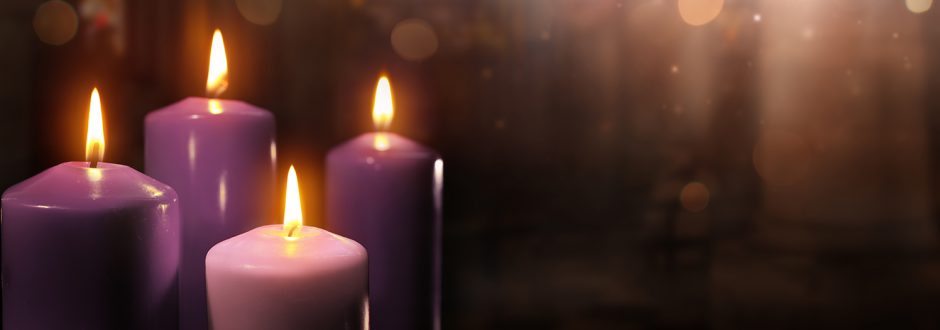Countercultural to our twenty-first century living, Advent presents a rare and precious opportunity to prioritise ‘unproductive’ time and allow space for personal and communal spiritual encounters, writes Monica Dutton.
By Monica Dutton
She arrives quietly… a whisper of grace.
In a way, she is like the reserved child of the family – so often overshadowed by her more popular siblings. Although dressed in purple, she has none of the gravitas of Lent. Nor does she possess the joy of Christmas, the triumph of Easter, the intensity of Pentecost, or even the constancy of Ordinary Time. While she ushers in the new year, there are no fireworks and no fanfare. She faithfully prepares the way and like Wisdom, waits to be found. She is gentle. She is patient. She is Advent.
The period of waiting gifted by Advent is not universally appreciated. With the Christmas season beginning earlier each year, Advent is overtaken in the rush and seems to have all but disappeared into the interminable abyss of commercialism and secularism. We have become almost immune to the ‘Hallmarkisation’ of religious festivals and seasons, where ‘holy days’ have become ‘holidays’. Advent is no exception.
A quick Google search reveals an astounding array of Advent Calendars for sale, including offerings from toy and confectionary manufacturers, beauty product companies and fitness studios. Never to be outdone in the marketing stakes, there is even a craft beer version which promises to “take your Beer Advent Calendar experience to the next level!” Unsurprisingly, rather than the first Sunday of Advent, these calendars invariably begin on December 1.
You can almost hear Advent’s disheartened and dispirited sigh.
The name Advent is taken from the Latin ‘adventus’, meaning ‘coming’. While its precise origins are unclear, Advent’s earliest appearance took the form of a three-week fast before Epiphany in the late 300s. After a number of modifications to its focus and duration, the first Sunday in Advent was declared the beginning of the liturgical year from around the ninth century.
Although being one of the shorter liturgical seasons, Advent offers singular opportunities for reflection. We are reminded in the Catechism that the waiting during Advent is twofold. We look back and recall the incarnation while remembering the promise that Christ will come again.
Similarly, the themes of the Sunday readings focus on the end of time, the ministry of John the Baptist, and the events preceding the birth of Jesus. The beautiful ‘O Antiphons’ also bring both fervour to the preparation for Christmas and a joyful conclusion to the season. Signifying the titles of Christ, the seven antiphons – O Wisdom, O Adonai, O Flower of Jesse, O Key of David, O Radiant Dawn, O Desire of Nations, O Emmanuel – are said to have been so ordered by the Benedictine monks, and have been part of a gentle rhythm of prayer for over 1000 years.
Perhaps the most widely recognised symbol of the season is the Advent Wreath. Dating back to the fifteenth century, its circular shape epitomises eternity; the greenery, new life; and the candles, the light of Christ. Traditionally the three purple candles represented preparation, penance and sacrifice, and the rose candle represented rejoicing. More recently they have come to symbolise hope, love, joy and peace.
The Prophecy Candle, lit on the first Sunday of Advent, reminds us of the faith-filled hope of the prophets who foretold the coming of the Messiah. The Bethlehem Candle, symbolising love, is lit in the second week. Joy is at the heart of the third week, as the rose Shepherds Candle is lit, and in the fourth week, the Angels Candle signifies peace on earth. The central white Christ Candle is lit on Christmas Eve, indicating the light of Christ that has come into the world.
While the wreath is traditionally adorned with the greenery of its European origins, perhaps it is time to consider the stunning purple, violet and amethyst blossoms which appear in the bright sunshine of our southern summer skies. As we anticipate the warmth, which encourages the blooming of jacarandas, wisterias, agapanthus, tibouchinas and bougainvilleas, we are again reminded of the significance of waiting in this beautiful season.
The patience and waiting desired of us by Advent are, however, countercultural to twenty-first century living. Waiting is perceived to be a negative attribute. Time is lost and productivity is compromised. Everything is urgent. We wait for nothing. This generalised impatience seeps ever more insidiously into the depths of our being, like a vague, indeterminate melancholy.
We have lost the notion of anticipation – of delighting in the first berries of summer or the stone fruits of winter. They are now readily available all year round.
Instant connectivity and ease of access to everything are now as essential to life as breathing. However, this unlimited availability comes at great cost. Globalisation has led to polarisation. Despite being more closely connected than ever before, we are utterly disconnected. Wants and needs being met ‘on demand’ do not quench our insatiable desire for more. Remote online ‘friends’ do not fulfil our yearning for meaningful relationships. We have everything and yet nothing satisfies. Our lives are full and yet our hearts are empty.
Advent then, presents a rare and precious opportunity. Prioritising ‘unproductive’ time and allowing space for personal and communal spiritual encounters inspire the contemplative stance borne of prayerful waiting. It is a time to reset our inner compass and to seek clear direction. The four candles of the Advent Wreath are personal reminders to each of us to question, to consider and to discern: What do I hope for? What do I love? In what do I find joy? In what do I find peace?
As we rediscover this gentle whisper of grace in our lives, may we wait and prepare for the coming of the Christ Child in the hope of ecological conversion, the love of God’s mission, the joy of ecclesial community and the peace that comes from nurturing a culture of mutuality.
